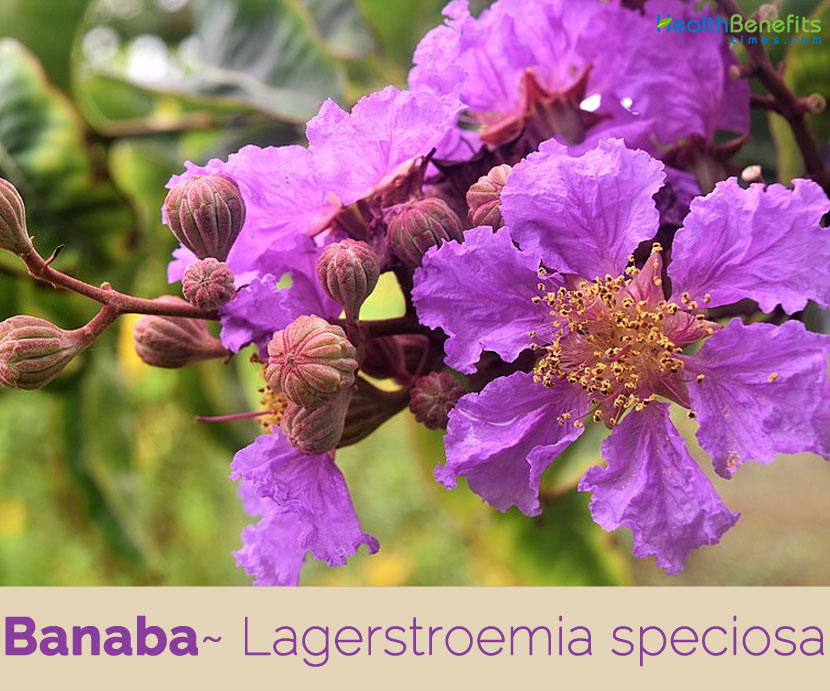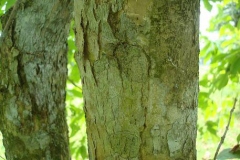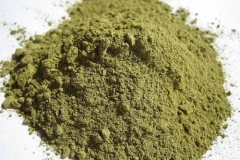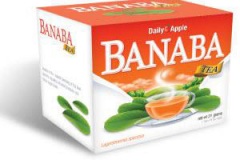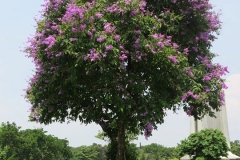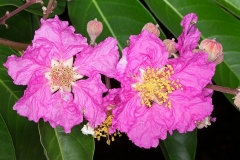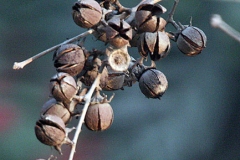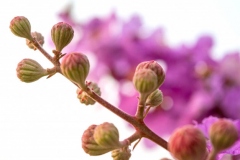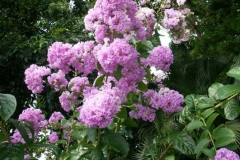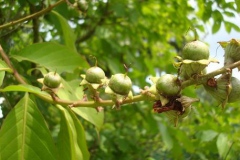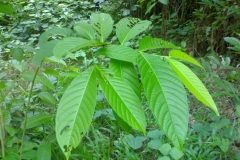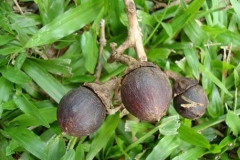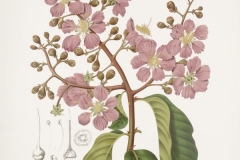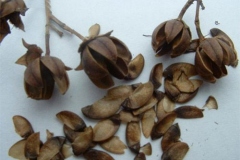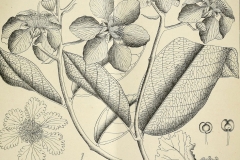| Banaba Quick Facts | |
|---|---|
| Name: | Banaba |
| Scientific Name: | Lagerstroemia speciosa |
| Origin | Temperate and tropical Asia including the Indian subcontinent, China, Cambodia, Myanmar, Thailand, Vietnam, Indonesia, Malaysia, and the Philippines |
| Colors | Initially green, then blackish when ripe |
| Shapes | Large nut-like capsule, obovoid or ellipsoid, and 2 to 3.5 centimeters long |
| Health benefits | Control Blood Sugar, Weight Management, Liver Disease, Viral Infections, Bacterial Infections, Heart Health, Natural Antioxidant, Potential Cancer Killer, Cures Gout, Urinary Tract Health, Kidney Health, Dry Skin and Acne, Metabolic Treatment, Digestive Problems |
| Name | Banaba |
|---|---|
| Scientific Name | Lagerstroemia speciosa |
| Native | Temperate and tropical Asia including the Indian subcontinent, China, Cambodia, Myanmar, Thailand, Vietnam, Indonesia, Malaysia, and the Philippines. This species has been widely cultivated as ornamental and is now naturalized in tropical regions of Asia and Africa, Australia, Mexico, Central and South America, and the West Indies |
| Common Names | Giant crape-myrtle, Pride-of-India, Queen’s crape-myrtle, Queen’s flower, rose of India, bloodwood |
| Name in Other Languages | Assamese: Aajaara (আজাৰ), Ejāra (এজাৰ), ajar, jarul Bengali: Jarula (জারুল) Borneo: Anunang, Bongor biru, Bungor, Bungur, Linang, Nunang, Sagawang, Tibabah Brazil: Flor-da-rainha, resedá-flor-da-rainha, resedá-gigante Burmese: Gawkng uchyamang, Hani, Mai-sa-hpong, Pyinma, Pyinma-yetthey, Thwemu Chinese: Da hua zi wei (大 花紫薇), zi wei shu Cuba: Astronomía, cupido, gastroomia, júpito Dominican Republic: Almira, armira Dutch: Koninginnebloem English: Giant crape-myrtle, Pride-of-India, Queen’s crape-myrtle, Queen’s flower, rose of India, bloodwood Filipino: Banaba French: Lilas des Indes, stragornia blanc, lilas d’été German: Königinblume, Rose von India Gujarati: Jarula (જારૂલ), moto bhondaro (મોટો ભોંડારો), taman (તામન) Haiti: Atromelia stragornia Hindi: Arjuna, Jaral (जारल), Jarul (जरुल) Kannada: Challa, Holedachalla, Hole daasavaala (ಹೊಳೆ ದಾಸವಾಳ), Maruvachala, Neernbendaka, Nirbendeka, Varibendeka, maruva (ಮರುವ) Konkani: Sotulari (सोटुलारी) India: Adamboe, ajhar, arjuna, ary, bondaro, challa, cholaventekku, hole dasal, hole matti, jarul, jarulo, kadali, mani maruthu, marathi-bendara, mota bondara, moto-bhandaro, nir maruthu, nirbendeka, nirventeak, patoli, patuli, pumaruthu, taman, varagogu Indonesia: Bungur, ketangi, Bungur tekuyung Jamaica: Crape myrtle, June rose Javanese: Ketangi Lesser Antilles: Crepe myrtle Malay: Bongor biru, Bungor kedah, Bungor raya, Bungur, Bungur tekuyung, Ketangi, Tibabah Malaysia: Berangan asu, bongor biru, bongor raya, sebugor Malayalam: Manimaram (മണിമരം), Manimaruthu (മണിമരുത്), Niir vantheekk (നീര് വന്തേക്ക്), Puumaruthu (പൂമരുത്), Shemmaruthu, adambu (അടന്പു) Manipuri: Jarol Marathi: Bondara, Jarul (जरुल), Motha bondara (मोठा बोंडारा), Taamhan (ताम्हण), Thamana, Motha Bondara (मोठा बोंडारा), taman Mizo: Chawn-pui, thla-do Myanmar: Gawkng-uchyamang, pyinma Netherlands: Koninginnebloem Oriya: Jarulo Philippines: Banaba, makablos, parasabukong Puerto Rico: Astromero Portuguese: Resedá-flor-da-rainha, Resedá-gigante Russian: Lagerstremiia iziashchnaia (Лагерстремия изящная), Lagerstremiya krasivaia (Лагерстремия красивая), Lagerstremiiaprekrasnaia (Лагерстремия прекрасная), Lagerstremiia reshnotsvetkovaia (Лагерстремия решноцветковая ), Lagerstremiia spetsioza (Лагерстремия специоза) Sanskrit: Arjuna, Jarula, kramuka, Mahaasona (මහාසොණ) Sinhala: Murutha (මුරුත) Spanish: Astromelia, embrujo de la India, orgullo de la India, astromera, flor de la reina Tagalog : Banaba Tamil: Katali (கதலி), Kadalimugai, Kadalippuva, Pantuvisakkari, Pittacamani, Pumarudu, Punkanai, Pu marutu (பூமருது) Telegu: Chennangi, Chinnangi (చిన్నంగి), Varagogu, Waragogu Thai: Chuang muu, Tabæk dả (ตะแบกดำ) Dtà-bàek dam, T̂n tabæk dả (ต้นตะแบกดำ) Dtôn dtà-bàek dam, Xinthnil (อินทนิล) In ta nin, Xinthniln̂ả (อินทนิลน้ำ) In ta nin nam United States Virgin Islands: Queen of shrubs Urdu: جارل Jaral, جرول Jarul Vietnamese: Bằng lăng , Bằng lăng nước, Bằng lăng tiên, Bằng lăng tím, Cây bằng lăng, Cây bằng lăng nước, Trái bằng lăng khô (dried fruits), Tử vi, Tử vi tàu Visayan: Bugarom, Duguam, Pamalauagon, Pamarauagon |
| Plant Growth Habit | Multi-stemmed, fast-growing, densely branched, deciduous or semi-deciduous shrub to small tree |
| Growing Climates | Gardens, yards, around parking lots, along highways. It can be found naturalized in waste places, disturbed sites, open grasslands, rivers, disturbed or secondary forest, forest edge in moist and dry habitats, and along roadsides in a great variety of climates |
| Soil | May vary from well drained to occasionally flooded, but not peat soil |
| Plant Size | Up to 40-45 m tall and 100 -150 cm in diameter |
| Bark | Bark surface smooth or with small papery flakes, grey to light fawn-brown mottled and peels off in flakes |
| Inner Bark | Fibrous, grey-fawn to yellow, turning dirty mauve or purple upon exposure |
| Leaf | Leaves are deciduous, oval to elliptic, 8–15 cm (3.1–5.9 in) long and 3–7 cm (1.2–2.8 in) broad, with an acute apex |
| Flowering season | In Philippines, in April-June, In Java in July-October, In Papua New Guinea in May-July |
| Flower | Flowers are produced in erect panicles 20–40 cm (7.9–15.7 in) long, each flower with six white to purple petals 2–3.5 cm (0.79–1.38 in) long. The flowers in this plant blooms only once in a year at the peak of summer. |
| Fruit Shape & Size | Large nut-like capsule, obovoid or ellipsoid, and 2 to 3.5 centimeters long |
| Fruit Color | Initially green, then blackish when ripe |
| Seed | Pale brown, with a wing 12 to 18 millimeters long |
| Propagation | By seed, by woody and semi-woody cutting, air layering, micro propagation and through the root suckers |
| Plant Parts Used | Leaves, Fruit, bark, seed, root |
| Culinary Uses |
|
| Health Benefits |
|
Plant description
Banaba is a multi-stemmed, fast-growing, densely branched, deciduous or semi-deciduous shrub to small tree that normally grows up to 40-45 m tall and 100 -150 cm in diameter. The bole is commonly short, cylindrical, often fluted near the base, branch-less for up to 18 m. The buttresses are inconspicuous, rounded, low and small. Bark surface is smooth or with small papery flakes, grey to light fawn-brown mottled. Inner bark is fibrous, grey-fawn to yellow, turning dirty mauve or purple upon exposure. Crown is usually bushy and spreading. The plant is found growing in gardens, yards, around parking lots and along highways. It can be found naturalized in waste places, disturbed sites, open grasslands, rivers, disturbed or secondary forest, forest edge in moist and dry habitats, and along roadsides in a great variety of climates. The plant may vary from well drained to occasionally flooded, but not peat soil.
Leaves
The leaves, on a 0.5-1 cm long petiole, are simple, opposite or sub-opposite, oblong-elliptic with entire margin and acute or obtuse apex, 5-22 cm long and 4-10 cm broad, coriaceous, of intense bright green color above, paler below, that turn orange red before falling.
| Leaf arrangements | Opposite/sub opposite |
| Leaf Type | Simple |
| Leaf Margin | Entire |
| Leaf Shape | Elliptic (oval), obovate, oblong |
| Leaf Venation | Pinnate, brachidodrome |
| Leaf type and persistence | Semi-evergreen |
| Leaf blade length | 4 to 14 inches |
| Leaf Color | Dark green on top, paler green underneath |
| Fall Color | Red |
| Fall Characteristics | Not Showy |
Flower
Terminal panicle inflorescences are erect, 15-40 cm long, carrying numerous flowers, on a 1-1.5 cm long pedicel, of color varying from pale pink, to lavender, to purple pink, of 5-8 cm of diameter, lasting 2-3 days. The sepal is funnel or bell-shaped and 6(-9)-lobed. Petals are oblong-obovate or obovate, shortly clawed, and 3 to 3.5 centimeters long; the margins are undulate and hardly fimbriate. They are white to pink or purple, clawed and wrinkled. The stamens are many and in several rows. The ovary is superior, 3-6-locular with many ovules in each cell and with 1 style. Flowering normally takes place from April-June in Philippines, from July-October in Java and from May-July in Papua New Guinea.
| Flower Color | Bright pink or lavender |
| Flower characteristics | Very showy; ruffled-looking and emerges in clusters on 1-2’ long, terminal panicles |
| Flowering | Late spring to summer |
Fruit
Fertile flowers are followed by a large nut-like globose, woody capsule, obovoid or ellipsoid, and 2 to 3.5 centimeters long and broad. Fruits are initially green turning to blackish when ripe containing numerous winged seeds. Seed is pale brown, with a wing about 12 to 18 millimeters long of pale brown color.
| Fruit shape | Round |
| Fruit Length | Less than 0 .5 inch |
| Fruit Covering | Dry or hard; woody, berry-like capsule |
| Fruit Color | Green to brown with maturity |
| Fruit characteristics | Does not attract wildlife; not showy; fruit/leaves not a litter problem |
| Fruiting | Fall |
Health benefits of Banaba
Banaba is an herbal remedy extract from the leaves of Lagerstroemia speciosa. Several researches have shown that Banaba is one of the plants that have a wide range of health benefits. It is considered alternative medicines to different health concerns like diabetes, high blood pressure, high cholesterol, kidney disease, UTI and metabolic syndrome that is why it is being marketed now in the form of supplements. Listed below are some of the popular health benefits of banaba
1. Control Blood Sugar
Another remarkable effect of the use of banaba leaf is its ability to help lower blood glucose levels in people with diabetes. Investigation from the Suzuka University in Japan found that the leaf was able to improve glucose uptake in both test tube and animal studies, providing a significant improvement in blood sugar levels. Results recommend banaba leaf could be of help as an adjunct treatment for diabetes. Compounds such as corosolic acid and tannins appear to be the components with anti-hyperglycemic effects. (1)
2. Weight Management
Several evidences shows that taking banaba leaf on a regular basis can help obese individuals lose weight and maintain better weight control. Compounds within the leaf appear to block fat absorption in the body, preventing the storage of fat in body tissues. It also acts by improving glucose utilization in the body. (2)
3. Liver Disease
Compounds in banaba leaf also appear to help protect the liver. These components appear to break down fats that can gather in liver tissue, leading to fatty liver disease and other conditions. Research from the University of North Bengal in India found that Lagerstroemia appears to have the effect of breaking down adipose components in the bloodstream, which is then prevented from accumulating in the liver. (3)
4. Viral Infections
The use of banaba leaf as a medicinal compound has included its service as a natural remedy for relieving viral infections. About half of the cases of the common cold are caused by viral agents that attack the respiratory system, causing symptoms of severe rhinitis. Research has discovered that ellagic acid, one of the active components of banaba leaf, was found to be effective against three common viral agents involved in the occurrence of rhinitis symptoms. Banaba leaf’s anti-viral properties are being studied at as an assistant treatment for HIV infection, to improve patients’ ability to fight the disease. (4)
5. Bacterial Infections
Banaba leaf has also been used traditionally as an anti-infective agent and for lowering fever caused by infections. A study from the University of the Philippines investigated banaba leaf for use against some common infectious agents and found that it was highly effective for reducing these infections, with results occasionally similar to pharmaceutical antibiotics. (5)
6. Heart Health
Banaba leaf is quite effective in treating metabolic syndrome, a group of pre-diabetic conditions that increases susceptibility to heart disease and stroke. Researchers at Mukogawa Women’s University in Nishinomiya, Japan found that by the end of 10 weeks of treatment with banaba leaf, blood pressure had been dropped, fat metabolism had normalized, and the body’s inflammation levels had decreased.
7. Natural Antioxidant
Leaves consist of the minerals manganese and zinc. Extracts from the seeds have been found to have powerful antioxidant properties and are in fact being investigated as a possible HIV treatment.
8. Cures Cancer
Banaba plays an important role in the fight against cervical cancer. When taken on a daily basis, it has been shown to encourage the body’s release of cancer- killing agents that help to stop the cancer in its tracks. Other forms of cancer, such as leukemia and breast cancer are extremely susceptible to the effects of Banaba as well.
9. Cures Gout
Banaba is considered a very safe and effective natural treatment remedy for gout. For centuries, Filipinos have boiled the leaves and used them to treat gout. Leaves consist of valoneic acid dilactone or VAD, which is extremely effective in preventing the xanthine oxidase enzyme from producing uric acid. High amounts of uric acid in the body crystallize and cause devastating pain and inflammation. Reducing the amount of excess uric acid in the body prevents the formation of gout. Popular uric acid management supplement, such as Urcinol, also consists of Banaba.
10. Urinary Tract Health
Urinary tract infections are a common problem that affects millions of individuals around the world. Generally, pain-relievers and heat are used to relieve symptoms of pain, cramping and inability produce adequate amounts of urine to flush out bacteria from the urinary tract. In severe cases, several different types of antibiotics are used to remove the infections. Banaba leaf also has traditional use for urinary tract infections and kidney problems. The anti-inflammatory properties of the components are supposed to have a soothing effect on urinary tract tissues, while anti-bacterial effects remove the infectious agents. Banaba leaf was traditionally soaked into a tea to relieve symptoms of UTI.
11. Kidney Health
Banaba is a cost effective and safe medication for people that suffer from poor kidney health. When taken daily, Banaba tea or supplements forces toxins from the kidneys and encourages healthy function.
12. Dry Skin and Acne
When used as a topical agent, Banaba helps to reduce the amount of lipid content in the skin, which helps to prevent premature aging, skin atrophy and other skin conditions. Banaba is also high in calcium, zinc and magnesium making it an effective natural remedy to use to counter the effects of acne and dry skin.
13. Metabolic Treatment
Metabolic syndrome includes a variety of health conditions, including high blood pressure, heart disease, obesity, and inflammation. Banaba is beneficial in the treatment of metabolic syndrome. When regularly taken, it lowers blood pressure, regulates fat metabolism and reduces inflammation.
14. Digestive Problems
One of the traditional uses for banaba leaf is to calm the stomach and improve digestive function. Components within banaba leaf appear to have a beneficial effect on gastrointestinal tissue and improve intestinal function. Sipping banaba tea is the traditional use of the compound for this complaint.
Traditional uses and benefits of Banaba
- Decoction of the bark is used against diarrhea and abdominal pains.
- Leaf poultice is used to relief malarial fever and is applied on cracked feet.
- Preparation from dried leaves, known as “banaba” is widely used across Asia to treat diabetes and urinary problems.
- Its old leaves and mature fruit are used in traditional medicine for reducing glucose in blood.
- Banaba is also used in Ayurvedic medicine for the treatment of diabetes in India.
- Folkloric uses of Banaba herbal medicine include the treatment for diarrhea, constipation, inflammation of kidneys, dysuria and other urinary dysfunctions.
- Roots have been used for a variety of stomach ailments.
- Infusion of bark used for diarrhea.
- Bark, flowers and leaves used to facilitate bowel movements.
- Decoction of fruits or roots gargled for aphthous stomatitis.
- Decoction of leaves and flowers used for fevers and as diuretic.
- Leaf decoction or infusion used for bladder and kidney inflammation, dysuria, and other urinary dysfunctions.
- Seeds considered to have narcotic properties; also used against aphthae.
- It is widely used in the Philippines to treat diabetes and urinary problem.
Who should consider taking Banaba
- Anyone with type 2 diabetes, pre-diabetes, or at high risk of developing diabetes should consider taking a banaba supplement.
- People with high cholesterol levels in their blood may also want to consider incorporating banaba.
- Patients with fungal or viral infections could also benefit from a banaba supplement. As could patients with inflammation, whether it is due to autoimmune conditions, arthritis, gastritis, or some other inflammatory disease.
- People who are overweight or obese may want to take banaba as well. The same goes for those with metabolic syndrome.
- If you have fluoride overexposure from your drinking water, banaba may help to minimize the effects.
- Those with liver disease, whether it’s alcoholic or non-alcoholic, may also benefit from taking a banaba supplement.
- Patients with cancer (particularly hepato-cellular or colorectal cancer) should also consider taking this supplement.
- HIV patients may also want to consider taking banaba.
Method of Using Banaba Herb for Diabetes
The following details the preparation and application of Banaba herbal medicine for diabetes
- Dry Banaba leaves and fruits for about two weeks.
- Cut Banaba leaves into pieces.
- Boil the dried Banaba leaves and fruits in water.
- One cup of dried banaba leaves and fruits to one cup water.
- Let it steep for 30 minutes.
- Strain the leaves and fruits.
- Take the Banaba herbal tea for 4 to 6 times daily.
Other Uses
- Banaba is planted for erosion control and as a support for rattan canes in Asia.
- It has been used in reforestation of degraded hills In Java.
- Pride of India or Tāmhan in Marathi is recognized as the state flower of the state of Maharashtra in India.
- Wood is used for railroad ties and construction in India.
- Banaba makes a useful timber tree.
- Tree has a dense and wide spreading root system, which has made it useful in plantings for erosion control.
- It has been used in reforestation schemes for degraded hills in Java.
- It is reported to be popular for use in boat building in Thailand and some parts of the Indo-China regions.
- The wood is also used for fuel.
Precautions
- Banaba can affect blood sugar control, so people with diabetes should monitor their blood glucose levels closely.
- Taking banaba might make blood pressure become too low in people with low blood pressure.
- Banaba might affect blood sugar levels and could make blood sugar control more difficult during and after surgery. Stop using banaba at least 2 weeks before a scheduled surgery.
References:
https://www.itis.gov/servlet/SingleRpt/SingleRpt?search_topic=TSN&search_value=27111#null
https://npgsweb.ars-grin.gov/gringlobal/taxonomydetail.aspx?id=21399
https://www.cabi.org/isc/datasheet/29704
https://www.wikidata.org/wiki/Q1137593
https://plants.usda.gov/core/profile?symbol=LASP
https://en.wikipedia.org/wiki/Lagerstroemia_speciosa
https://edis.ifas.ufl.edu/st349
https://gd.eppo.int/taxon/LAESP
http://www.theplantlist.org/tpl/record/kew-2353907
https://indiabiodiversity.org/species/show/265016
http://www.stuartxchange.org/Banaba.html
http://tropical.theferns.info/viewtropical.php?id=Lagerstroemia+speciosa
https://www.dominicagardens.com/lagerstroemia-speciosa.html


